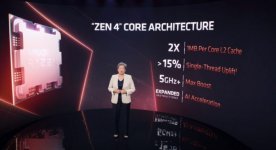The AM5 socket allows for a higher TDP of 170W (up from 145W)
This one I do not understand. They're running about the same number of pins that Intel is, which does make sense, and Intel 12th-gen CPUs would pull 400W+ through the socket if you let them and could keep them cool. And that's nothing new.
Either AMD is sandbagging in terms of what the socket is capable of - and just look at those 22 stages of 90A power on the premiere motherboards! - or these are 'marketing' numbers. First crop of AM5 boards are more overbuilt than the top-end 12th-gen boards were when it comes to power delivery.
Higher boost clocks - up to 5.5Ghz.
Alder Lake can do this on ambient cooling, assuming that it's very very good ambient cooling and one has a very very good sample (so the best of the 12900KS CPUs). What will be impressive is Zen 4 hitting that speed more often and doing so at less frightening voltage and subsequently power draw levels.
And an IGP on the I/O die!
This has been a criticism of mine concerning Ryzen for a long time. AMD has leading graphics IP, and they just left that on the table. The APUs were also seriously neglected.
I'm not expecting competitive gaming performance here; I'd actually not even want that - but getting modern graphics IP in there is
huge. AMD really needs a competitor to Quicksync, not just the hardware but also industry support, and this will help them get the marketshare to drive adoption.
There's a rumor that there could be low power CCDs and high performance CCDs - similar to little.BIG that Intel and Apple have moved to - but I can't find anything concrete about that.
I'm getting the "yes, but not yet" impression. It seems that, on paper, Zen 4 cores won't be as stout as the P-cores found in Alder Lake. Or maybe only
just. Right now it does make sense for them to push their peak performance, as that's where they can really win mindshare; they fall behind there, and their marketing challenge grows.
And from what we've seen in the mobile space, AMD looks to be very close in terms of efficiency, and seemingly ahead when power limits drop to ultrabook levels.
There's rumor that V-cache from the 5800X3D will be present, but again, I can't find anything concrete.
I'm betting they're split on this. The v-cache limits thermal headroom which then puts a serious cap on raw compute throughput - so it's only useful when the CPU is cache limited. And there's only so many consumer applications where that's the case.
In other situations, the v-cache makes the CPU both more expensive to produce and slower, and from the enthusiast perspective, harder to cool for peak performance.

